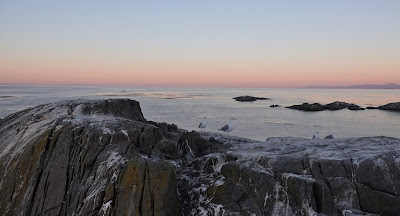The day started with what was going to be another seawatch, but distractions got in the way. My first look through my scope landed on a small group of Orcas in the distance. Despite my attempts to alert the volunteers, it was sadly another miss! Those were the only whales I saw today, and the whalewatching boat numbers were way down from Saturday, despite great flat-water conditions. I can only guess that there were whales closer to town today, keeping the boat traffic down. There were several passerined that passed over today, frustrating fast and when I had my hands full, so no identifications.
I did see something unusual from my perch near the solar panels. Can you identify it?
 |
| What is that behind the murres? |
 |
| A close-up |
Puzzle pieces started to fit together about the log boom I saw a couple of days ago. During the Sooke Christmas Bird Count, my area includes the William Head Institute. I recall now seeing piles of logs at one end of their parking lot. They operate a small sawmill there, I suspect as a training opportunity for soon-to-be released inmates. The tugs were definitely headed in that direction!
One of the attractions of a barely inhabited island is that it is a great place to raise a family. In a place like Race Rocks, the species diversity of breeders, at least above water, is quite limited, but the numbers can be quite high. Last year when I was here, I counted about 800 Glaucous-winged Gulls. This year, there are about half that, and reports from others indicate that survival of chicks was not good. That said, the parents are fierce defenders, and do their best. While it's difficult to say what is the issue this year, I hear reports of similar failures on other islands. I watched one gull feed a piece of fish to one of its chicks, then grab a mouthful of dirt and grass for the other two. Despite the action on the ocean, is it possible that gulls are having a hard time finding food this year?
 |
| Glaucous-winged Gull chicks at sunset |
Another species of bird that breeds here is the Pigeon Guillemot. While it doesn't look like everyone in the group is breeding, I've found two likely nest locations. The parents are quite secretive about it when humans are around, and won't enter the spot if they think you are watching. But still, I've found two so far. I can't help but thinking that any number of gulls have also been watching these parents bringing in food and are just waiting for the opportunity to grab the young chicks when they make an appearance.
Black Oystercatchers also breed here. While this population is considered stable, the estimate is that there are only about 15,000 in the world. Gulls have been observed preying upon them here, too. It seems a longshot to have offspring survive in a gull colony.
 |
| Black Oystercatchers |
Black Turnstones don't breed here, but come shortly after leaving their breeding grounds in western Alaska. Once here, they start to molt their feathers. You can see some new primaries (wing feathers) coming in to replace the old ones in the photo below. Many turnstones will remain in our area over the winter, but others will continue south as far as Baja California.
 |
| Molting Black Turnstone (special treat for my bird banding colleagues) |
Of course, mammals also breed on Race Rocks. Harbour seals proliferate, much to the chagrin of many fishermen. There are dozens of adults and pups around the edge of Great Race and on the smaller islands.
In recent years, northern elephant seals have started pupping here as well, but the survival rate has been low. Most common cause of death has been being crushed by the male in his attempts to mate with the females. He's not about to let a pup get in the way! This year, though, the survival has been good, with a few pups still hanging out around the island. One (presumed female) has been following Bubbles around, but he's not a real family guy. Today, while two young elephant seals were on the jetty ramp, Jeremias took a bit of a swim off the dock. While Abi and I were keeping an eye on nearby marine mammals, the alpha elephant seal came around the corner and swam right below him. (It was a little scary, but looked REALLY cool! Bubbles didn't take much notice of Jeremias, who very quickly got out of the water, but was not happy about the pups blocking his way.
Mushu is settling in and actually got up the nerve to look out the window today. What a culture shock from living in the middle of a forest! He wasn't keen on human visitors, though, and went back under the bed. He also discovered he could work his way under the comforter on the bed to be both comfy and hidden.
The volunteers leave tomorrow and I will be on my own for a while. I'm starting to settle in to a rhythm of my own, but I have a project or two up my sleeve.
 |
| Great Blue Heron |
 |
| Bubbles suggesting the pups get out of the way |
 |
| Surfbird |
 |
| Sunset looking south |
 |
| Discovery Princess departing at sunset |
 |
| Sunset looking southwest |





No comments:
Post a Comment